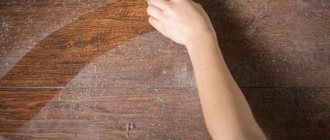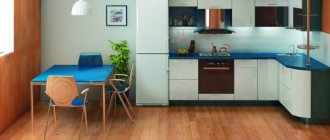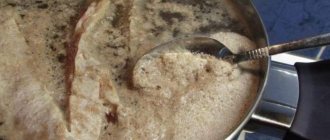The microclimate in an apartment has a significant impact on the health and well-being of its inhabitants. Weakness, loss of performance, increased susceptibility to viral and colds, skin diseases, allergies - this is what dampness in an apartment can threaten. In addition, high humidity causes wooden and leather products and books to deteriorate, and finishing quickly becomes unusable, so to maintain health and home comfort, it is absolutely necessary to combat dampness.
How do you know if the humidity in an apartment is above normal?
You can recognize high humidity in a room by the following signs:
- Fogging of glass surfaces (windows, glass doors, mirrors).
- Wet spots on the walls of the apartment, fungus, mold.
- Wet towels, bed linen, clothes in closets.
- The smell of dampness and mustiness.
Prevention
To avoid problems with dampness in the future, follow these simple rules of prevention:
- Turn on forced ventilation every time after taking a shower, bathing or drying clothes.
- Try to leave the bathroom door open for a couple of hours after taking a shower or bath, and wipe off excess water from the floor.
- Ventilate all rooms in the apartment more often. At least once a day.
- In summer, try not to shade window openings, but rather open them. The sun's rays are a natural "disinfection" with ultraviolet light and a good way to dry.
- After wet cleaning, try to wipe surfaces dry or ventilate rooms.
Prices for drying services
| Service | Price | Price per 1 m2 |
| Removing mold and mildew | 350 rub. | 350 rub/m2 |
| Dehumidification of one room | 2500 rub. | 300 rub/m2 |
| Drying ceilings: suspended and suspended | 2600 rub. | 300 rub/m2 |
| Drying a plasterboard ceiling | 4,000 rub. | 300 rub/m2 |
| Drying wet spots on walls | 2400 rub. | 250 rub/m2 |
| Draining walls | 2300 rub. | 300 rub/m2 |
| Removing water from the floor or under the floor | 2000-3000 rub. | 250 rub/m2 |
| Drying under parquet | 4,000 rub. | 300 rub/m2 |
| Drying the laminate | 3,000 rub. | 290 RUR/m2 |
| Drying damaged furniture | 3,000 rub. | — |
| Antifungal treatment of any surfaces | 3,000 rub. | — |
| Drying plaster or screed after repair | 3,000 rub. | 300 rub/day |
| Drying of building materials (concrete, wood) | 2,500 rub. | — |
| Comprehensive drying of country houses | 5,000 rub. | — |
Availability of sources of additional moisture
They can serve as:
- Leaking plumbing or pipes. The solution is to check, repair or replace everything you can.
- Flowers. Tropical plants that require frequent watering should be removed from the apartment, giving preference to unpretentious species that will not evaporate a lot of moisture.
- Aquariums in the apartment. If the humidity problem is serious, you will have to give up this hobby and remove the aquarium.
- Large amount of water on the lower floor. This could be a basement, a swimming pool, etc. It’s difficult to do anything here; appeals to the housing office with a request to improve the microclimate of the basement are ineffective, and you can’t get rid of the pool, all that remains is to change your place of residence or install a powerful dehumidifier in the apartment.
- Unscrupulous upstairs neighbors who periodically flood your apartment or have leaking taps. The last factor makes your pipes “sweat” and “cry”. The resulting condensation increases the humidity in the apartment. You can get rid of the problem by calling a mechanic from the housing and communal services; in extreme cases, you can resort to using polyurethane casings by wrapping them around a wet pipe.
USEFUL INFORMATION: What is the optimal air humidity in an apartment?
How to remove damp smell
Often high humidity is accompanied by a characteristic smell of dampness. Its cause is a fungus, therefore, in order to eliminate the problem, the infection must be destroyed. Thoroughly wash away mold stains; if it has become deeply embedded, replace the coating (down to the layer of plaster), if possible. Then treat with a disinfectant compound, and then with a protective one. Products must be labeled “antifungal” or “fungicide.”
To prevent mold from growing again, in addition to treating with protective agents, you will need in warm, dry weather:
- arrange a draft in the apartment, which will ensure good ventilation;
- hang carpets, bed linen, curtains, clothes outside to dry and disinfect under the sun's rays.
Advice! In winter, heaters, household dehumidifiers, and air conditioners that are equipped with a heating function will allow you to dry the room.
Humidity due to improper insulation
If all previous reasons are excluded and you are firmly convinced that the increased humidity in the apartment is due to poor-quality insulation, then legislation and engineering reports with thermal calculations of the walls of the room will help you to determine the required thickness and material of the insulation. Depending on the situation, you may need:
- sealing joints between slabs;
- internal insulation of the apartment;
- insulation of the wall outside the building.
You can find out where moisture is coming into the apartment from using a piece of glass. Place it against the wall for a few minutes. If the side that was pressed against the wall becomes damp, dampness enters the apartment from the street due to defects in the building's design.
Home remedies to combat fungus and dampness indoors
In addition to industrial compounds, you can use effective and inexpensive home-made products to combat fungus.
- Take 0.5 kg of laundry soap, grate and dissolve in 5 liters of water.
- Boil the resulting mixture and cool it.
- In warm summer weather, brush several coats of soapy water onto moldy walls without wallpaper.
- Then cover them with a composition prepared from 100 g of alum and 6 liters of water.
You can deal with dampness using calcium chloride, placing it in the corners. To reuse it, it must be dried under high temperatures and then covered. Charcoal and quicklime are suitable substitutes. However, when using this method, care should be taken to ensure that these substances are not accessible to children or pets.
Insufficient heating
If you have an apartment with individual heating, then the problem of high humidity is easily solved. In winter, you can regulate the heat supply yourself, reducing or increasing it as needed, but without sudden changes that will aggravate the situation. In damp and humid weather, you need to turn on the heating to dry.
What to do if, with centralized heating, the apartment is not warm enough and because of this the humidity rises?
- Cold pipes may be the result of a lack of heat supply by boiler houses or the initiative of neighbors who decided to remove the bypasses. The solution is to contact utility services.
- Installed decorative grilles on radiators reduce heat transfer by a quarter. It's better to give them up completely.
- Paint on batteries can also reduce heat transfer by 10%; to avoid this, it is necessary to remove the previous layer before painting.
Signs of Low Humidity
characteristic signs
- Dry wooden furniture that does not close well;
- Gaps between parquet planks;
- Quickly drying soil in pots with indoor plants;
- Increased static electricity;
- The smell of dust from drapes and curtains;
- Difficulty ironing clothes and bed linen;
- Dry skin and brittle hair.
Dry air in living rooms can cause serious illnesses. At first, a person experiences only a feeling of thirst and slight discomfort. These symptoms are replaced by fatigue, burning eyes, drowsiness, and poor appetite.
Over time, the body’s water balance and the protective functions of the mucous membranes are disrupted, and immunity is sharply reduced. Allergic reactions to dust can develop into chronic diseases of the bronchi and lungs.
Ventilation
Ventilation in the apartment is mainly ensured by the presence of ventilation shafts. Ventilation openings and ventilation ducts leading to common shafts are located in places with high humidity: in the bathroom and kitchen. If you have checked the ventilation and found that the draft is weak or absent, one of the following reasons occurs:
- The channel may be clogged with debris. You can get rid of the blockage by cleaning it.
- One of the neighbors, when remodeling or improperly installing the hood in the kitchen, blocked the exhaust shaft. Solving the problem can take a lot of time and effort, if the neighbors do not make contact, there is no need to fight with them, it is better to immediately contact the utility companies first, and then go to court.
USEFUL INFORMATION: Features of the construction of a Russian bath
There are several more ways to solve the problem of high humidity in an apartment due to poor ventilation:
- Installation of a forced ventilation system. Its disadvantages include some financial costs associated with the purchase of a fan and increased energy consumption, as well as noise. Plus - solving the problem once and for all.
- Installation of a recuperator - a special device that extracts humid air and provides an influx of fresh air. It’s not a cheap thing, but it’s guaranteed to reduce the humidity in the apartment.
Effective ways to reduce humidity
And yet, the problem of high humidity in the apartment can be solved. Below we discuss in detail several ways to combat it, which will not be difficult to implement. To achieve the desired result, it makes sense to use several of them simultaneously.
In order to make sure that the air humidity in the room is exceeded, we suggest using the following devices.
Option No. 1 - ventilation of the apartment
The proposed method of air drying is simple and accessible, but at the same time quite effective. Please note that it is necessary to ventilate the room only in dry and windy weather - otherwise the event loses all meaning.
It is especially important to ventilate after cooking, taking water procedures, washing or general cleaning, accompanied by the use of a washing vacuum cleaner.
Ventilation is the simplest, but at the same time very effective way to combat high humidity in an apartment. In addition, by ventilating the room, you provide an influx of fresh air enriched with oxygen.
An interesting point about how to reduce the humidity level in an apartment in summer, spring and winter. Everything is very simple - to solve the problem, if the humidity is high, but not too much, a powerful fan will do.
Using this device, you can dry the air in the room - it is not always possible to ventilate it.
Option #2 - heaters and dehumidifiers
If the humidity levels in the room exceed all permissible limits and you constantly feel damp, you will have to think about buying household dehumidifiers. Unlike industrial devices, these are compact and operate silently. And they do not have to work constantly - to successfully combat humidity, it will be enough to turn on the device 2-3 times a week.
The use of heaters in the cold season, outside the heating period, not only provides pleasant warmth, but also reduces the humidity in the room
In the cold season and early spring, heating devices provide excellent protection from dampness. The heat they generate significantly dries the air - but you need to be careful here, because there is a risk of drying it out.
In order not to overdo it in the fight against high humidity, do not use heaters during the heating season.
Option No. 3 - modern finishing materials
Do you want to provide long-term protection against dampness? Prepare for a major overhaul.
The use of non-natural materials contributes to an increase in humidity in the apartment, so it makes sense, if possible, to avoid the use of plastic and other types of finishes that retain moisture.
Carrying out “drainage” repairs involves performing the following activities:
- Removing remnants of previous finishing.
- Eliminate, if possible, the source of increased dampness.
- Using a heat gun allows you to dry the walls very well.
- Carefully seal all possible sources of high humidity. First of all, you need to pay attention to the joints of the walls and floor seams. For this purpose, the cracks are filled with cement mortar and treated twice with hydro- and bioprotective compounds. The most commonly used sealants are silicone based.
- The walls need to be treated with a water-repellent primer or bioprotection. The ideal option is to use both means.
- The prepared room must be finished with moisture-resistant plasterboard - one that has a green tint. The thickness of the plasterboard sheets is about 10–12 mm.
For interior decoration of homes with high humidity, non-woven wallpaper with vinyl coating should be used. This coating effectively resists moisture.
Moreover, when cleaning, non-woven wallpaper can be wiped with a damp cloth. If you do not want to use non-woven wallpaper, compact vinyl wallpaper will do.
Coating with acrylic paint not only prevents an increase in air humidity in the apartment and protects against fungus, but also looks great, allowing you to implement any design solutions
Acrylic paint and putty is a combination ideal for treating walls in rooms with high humidity. Acrylic itself is highly water-resistant, and mixed with putty, it provides a reliable water-repellent film.
Another suitable option for decorating wet rooms is ceramic tiles. But its high price limits its scope, so in the vast majority of cases its scope of use is limited to the kitchen and bathroom.
Although, if funds allow, living rooms can also be tiled, only the tiles themselves should be larger in size than those that were used to prevent the increase in humidity in the rooms mentioned above.
Option number 4 - anti-damp tablets
An effective remedy is special absorbent tablets. For example, Ceresit “Stop Moisture”, Henkel “Stop Moisture”. They are used in conjunction with a desiccant - a container into which the brine solution formed from the absorbed moisture flows. The proposed product can absorb about 0.4 liters of water per month.
Using anti-damp tablets is perhaps the simplest and most effective way to combat constantly high indoor humidity. They are ineffective only in the most advanced cases, when major repairs are necessary
Please note that the area of the room in which the absorbent tablet is used cannot be more than 20 square meters. m. 1 tablet can be used for 2-3 months.
Option No. 5 - folk remedies
If the air humidity in your apartment is slightly exceeded and dampness is not particularly felt, at least it does not lead to the formation of fungus.
Or the problem is acute and needs to be solved urgently, but at the moment you do not have enough money to begin a full-fledged repair, you can try to combat high humidity in the room with folk remedies.
Products with absorbent properties
Food products with proven absorption properties are:
- salt;
- sugar;
- rice cereal;
- coffee beans.
It is clear that there is no need to place bags of salt, rice or sugar right in the middle of the rooms. It is enough to pour the products listed above into small containers and place them in inconspicuous places - under the bed, on the chest of drawers, etc.
From coffee beans you can get not only a tasty and invigorating drink, but also an excellent remedy for combating high humidity in the apartment
At the same time, you need to remember that using sugar as a moisture-absorbing agent is fraught with attracting unwanted neighbors to your home - all kinds of insects like cockroaches, ants, etc., which are much more difficult to deal with than with high humidity.
Therefore, it is better to use any other products as natural absorbents. By the way, with the help of coffee beans you can make a beautiful decorative composition in a glass thicket - all you need to do is add other bright components there.
Using Silica Gel
Silica gel is a compound whose sachets can be found in many industrial products made from genuine leather (shoes, bags, wallets). The compound perfectly absorbs moisture. The only thing is that to reduce the humidity in the room, the amount of silica gel that you get with shoes and other leather products will clearly not be enough.
Who would have thought that with the help of these small bags you could solve the problem of high humidity in your home?
You can buy absorbent at a pet store - they sell silica gel as a component for cat litter. When working with silica gel, be extremely careful: under no circumstances should small children who want to try everything “by tooth” should have access to silica gel balls.
The ideal option is to use silica gel not in bulk, but to spread out fabric bags filled with this material.
Calcium chloride, coal and quicklime
If high humidity is observed exclusively in the non-residential areas of your apartment - pantry, vestibule, balcony, then it is permissible to use the substances listed above as absorbents. But in no case should they be used to reduce the humidity of a residential premises - this can cause a sharp deterioration in the health of household members.
The principle of using the substances listed above as absorbents is extremely simple. Calcium chloride, charcoal and quicklime are poured into containers previously placed in the corners of the damp room.
That's it, nothing else is needed - after six months the composition of the containers will need to be replaced, because the substance will be saturated with moisture to the limit.
Coal can become not only fuel for a fireplace, but also a means of combating high humidity. Use only large layers and do not break them
The safest option suitable for reducing humidity in living rooms is coal. However, you need to carefully ensure that it does not become a source of coal dust: this will have a detrimental effect on the health of household members.
Choose only large pieces of coal and under no circumstances place coal in walk-through areas. Lime is suitable for reducing humidity on a loggia/glazed balcony. If you are going to use calcium chloride as an inexpensive absorbent, do not forget to thoroughly dry it in the oven before use and then grind it.
Indoor flowers in the fight against humidity
Many people don’t even realize that some plants effectively absorb moisture, so indoor flowers can be used to solve the problem of increased dampness!
So, if you wish, you can combine business with pleasure by having indoor flowers that absorb excess moisture from the air. Please note that not all plants are able to absorb moisture effectively.
Absorbents of natural origin include:
- geranium;
- spathiphyllum;
- fern;
- myrtle;
- lemon;
- a coffee tree;
- laurel;
- syngony.
Only geraniums can be grown at home. Because all the other plants listed above need abundant watering.
Geranium will not only decorate your apartment, but will also protect your household from high indoor humidity.
Accordingly, they themselves can easily become a source of dampness and even mold in the room. Especially if there are several flower pots on one windowsill.
General recommendations
In addition to individual methods for eliminating humidity in an apartment, specific to each individual case, there are also general ones.
- Regular ventilation of the room. It has long been known that humidity is afraid of fresh air.
- Buying a dehumidifier. The more powerful the equipment, the greater the effect of its work, the faster you will be able to get rid of high humidity.
The best option is a dehumidifier with a humidity sensor that responds to the percentage of moisture in the room air. Automatic mode will help avoid over-drying and save energy.
Renovating apartments with high humidity has its own characteristics. Necessary:
- Use natural materials that do not create a greenhouse effect and regulate the level of humidity in the room, and avoid vinyl wallpaper, PVC panels and other vapor-proof materials.
- Do waterproofing.
- Add antifungal components to the mixtures used and treat against mold.
Humidity Reduction Techniques
For professional drying, special industrial drying machines are used. They allow you to provide an optimal microclimate in rooms of any size and purpose, and get rid of excess moisture that penetrates concrete floors, brick walls and wooden structures.
We use various professional drying equipment:
- condensation dehumidifiers - remove moisture from the air through condensation;
- adsorption - adsorb moisture due to special hygroscopic materials;
- duct - they pull moisture from the air and condense it in a cold radiator;
- refrigerated - remove moisture by lowering the temperature;
- ceiling - placed under the ceiling without occupying the working area.
Reasons for rising humidity
Dampness can appear in the house in two ways.
Infiltrate from outside
If there was a defect during construction work, moisture will likely appear in the house soon. Damp in the house may be due to the fact that the groundwater level has risen or, if the house is panel, water may seep through the joints.
Form inside
First of all, it is condensation. Dampness appears if the rooms are rarely ventilated or work is often carried out that causes an increase in humidity, for example, cooking or washing, if the room is poorly insulated, if pipes are leaking in the bathroom and in the ceilings between floors, or if there is a lot of various plants or aquarium there.
The effect of dampness on housing and people
In case of untimely actions aimed at eliminating dampness, or in case of ignoring the problem, unpleasant consequences will certainly arise.
- A persistent heavy smell characteristic of basements will appear in the apartment;
- Finishing materials, namely wallpaper or plaster, will begin to peel off. The putty saturated with moisture becomes loose and moves away from the surface of the wall or ceiling in whole layers;
- Wooden floors or floor coverings may become deformed, cracks will form at the joints of elements, and a characteristic creaking will appear;
- Furniture items made from natural materials will also be subject to deformation;
- When the humidity level exceeds the normal level for humans of 40-60%, this leads to an exacerbation of respiratory diseases or their development;
- Allergies may worsen;
- All microbes and bacteria develop much faster and more actively in a humid environment;
- Skin rashes will appear, wounds or scratches will take longer to heal or rot;
- Such a microclimate is especially dangerous for young children, whose immunity has not yet strengthened and cannot provide adequate resistance. Children are easily susceptible to illness and stay sick longer;
- A clear consequence will be the formation of black fungus, that is, mold, on the walls or ceiling.










